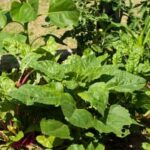When it comes to vegetable gardening, using pallets as containers has become a popular and innovative trend among gardening enthusiasts. Pallets offer a budget-friendly and eco-friendly solution for creating a vegetable garden, regardless of space limitations. In this article, we will explore the various benefits of using pallets for vegetable gardening, how to select the right pallets for your garden, and step-by-step instructions on preparing them for planting.
One of the key advantages of utilizing pallets for vegetable gardening is their versatility. These wooden structures can be easily repurposed into planters, providing a sustainable alternative to traditional gardening containers. Additionally, pallets are readily available and can often be acquired for free or at a low cost, making them an accessible option for beginners and seasoned gardeners alike.
By choosing the appropriate pallets for your vegetable garden, you can ensure optimal growth conditions for your plants. Selecting untreated or heat-treated pallets is essential to avoid exposure to harmful chemicals that may leach into the soil and affect plant health. Taking the time to inspect pallets for damage or contamination before use is crucial in creating a healthy growing environment for your vegetables.
Benefits of Using Pallets for Vegetable Gardening
Pallets are versatile containers that offer several benefits when used for vegetable gardening. Here are some advantages of utilizing pallets for your gardening needs:
- Cost-effective: Pallets can often be obtained for free or at a low cost, making them an affordable option for those looking to start a vegetable garden on a budget.
- Space-saving: Pallets can be stacked vertically or horizontally, allowing you to maximize your growing space in small areas such as balconies, patios, or even indoors.
- Easy to customize: With some basic tools and materials, pallets can be easily transformed into customized planters to suit your specific needs and preferences.
Moreover, using pallets for vegetable gardening promotes recycling and repurposing of materials, making it an eco-friendly choice for sustainable gardening practices. By giving new life to discarded pallets, you are contributing to reducing waste and promoting resourcefulness in your gardening endeavors.
In addition to being practical and environmentally friendly, using pallets for vegetable gardening also allows for better control over soil quality and drainage. Pallets provide good air circulation which aids in preventing waterlogging and root rot, resulting in healthier plants with improved growth and yield. Overall, incorporating pallets into your vegetable garden setup can offer a multitude of benefits that cater to both practicality and sustainability.
How to Choose the Right Pallets for Your Vegetable Garden
When it comes to using pallets for vegetable gardening, choosing the right pallets is crucial to ensure the success of your garden. Not all pallets are suitable for gardening, as some may have been treated with harmful chemicals that can leach into the soil and affect your plants. Here are some tips on how to choose the right pallets for your vegetable garden:
- Opt for heat-treated or untreated pallets: Look for pallets that have been heat-treated (marked with HT) instead of chemically treated. Heat-treated pallets are safe for gardening as they have been treated at high temperatures to kill pests and pathogens without the use of chemicals.
- Check for any spills or stains: Avoid using pallets that have visible spills or stains, as these could indicate that the pallet has been exposed to harmful substances during transportation.
- Select sturdy and intact pallets: Choose pallets that are in good condition with no broken slats or loose nails. Sturdy and intact pallets will provide a stable foundation for your vegetable garden.
By taking the time to select the right pallets for your vegetable garden, you can ensure a safe and healthy environment for your plants to thrive. Remember, safety should always come first when it comes to using pallets for vegetable gardening.
Step-by-Step Guide on Preparing Pallets for Planting
Pallets are not only a cost-effective solution for creating vegetable gardens, but they also offer a sustainable way to repurpose materials that would otherwise go to waste. Before you begin planting your vegetables using pallets for vegetable gardening, it is essential to prepare them properly to ensure the best growing conditions for your plants. Follow these step-by-step guidelines to get your pallet garden ready for planting.
First, select pallets that are in good condition and have not been treated with chemicals that could harm your plants. Look for pallets labeled with HT (heat-treated) rather than MB (methyl bromide), as the former is safe for gardening purposes. Next, thoroughly clean the pallets with a stiff brush and mild soap to remove any dirt, debris, or potential contaminants from previous use.
Once cleaned, consider lining the insides of the pallet with landscape fabric or mesh to prevent soil from spilling out while allowing proper drainage. This will help maintain the structure of the garden while keeping your plants healthy. After lining, fill each section of the pallet with high-quality potting mix or soil suitable for vegetables.
Make sure to pack the soil tightly into each compartment to avoid settling once planting begins. Now your pallet garden is ready for planting your favorite vegetables and herbs while utilizing vertical space efficiently. With proper preparation, using pallets for vegetable gardening can be a creative and practical way to grow fresh produce at home.
Best Vegetables to Grow in Pallet Gardens
When it comes to using pallets for vegetable gardening, there are several types of vegetables that thrive in this container system. Leafy greens like lettuce, spinach, and kale are excellent choices for pallet gardens due to their shallow roots and ability to grow in small spaces.
Herbs such as basil, parsley, and cilantro also do well in pallets, providing fresh flavor to your dishes right at your doorstep. Additionally, compact varieties of tomatoes, peppers, and cucumbers can be successfully grown in pallet gardens with proper support.
One of the key advantages of growing vegetables in pallet gardens is the flexibility it offers in terms of plant choice. Root vegetables like carrots, radishes, and beets can also be grown in pallets if the depth allows for proper root development. By choosing a variety of vegetables that have different space and sunlight requirements, you can maximize the yield from your pallet garden throughout the growing season.
Another benefit of using pallets for vegetable gardening is the ease of maintenance and care. Pallets allow for good drainage which helps prevent waterlogging and root rot. Regular watering, fertilizing, and monitoring for pests are essential tasks to ensure the health and productivity of your vegetable plants. With proper care, you can enjoy a bountiful harvest from your pallet garden while adding a touch of greenery to your outdoor space.
| Vegetable | Best Growing Conditions |
|---|---|
| Lettuce | Partial shade with consistent moisture |
| Basil | Full sun with well-draining soil |
| Tomatoes | Full sun with sturdy support for vines |
Tips for Maximizing Space and Yield in Pallet Vegetable Gardens
When using pallets for vegetable gardening, maximizing space and yield is essential to make the most out of your limited planting area. One effective way to do this is by utilizing vertical gardening techniques. Pallets can be easily transformed into vertical planters by adding shelves, pockets, or hanging containers for additional planting space. This not only optimizes the use of space but also allows for better airflow and sunlight exposure to all your plants.
Another tip for maximizing space and yield in pallet vegetable gardens is to carefully plan your planting layout. Consider the spacing requirements of each type of vegetable you want to grow and arrange them accordingly on the pallet. You can also plant companion crops together to maximize space utilization and beneficial interactions between plants. Additionally, consider succession planting to ensure a continuous harvest throughout the growing season.
In addition, implementing intensive gardening methods such as square foot gardening or intercropping can help increase yield in pallet gardens. By closely spacing plants together based on their growth habits and nutrient needs, you can grow more food in a smaller area.
Intercropping, which involves planting different types of vegetables close together, can also help deter pests, improve soil health, and maximize overall productivity in your pallet garden setup. By following these tips for maximizing space and yield, you can create a productive and efficient vegetable garden using pallets as containers.
Maintenance and Care for Pallet Vegetable Gardens
Watering
Proper watering is essential for the health and growth of vegetables in pallet gardens. Since pallets have limited space, it’s important to ensure that the soil remains consistently moist but not waterlogged. To prevent overwatering, consider adding drainage holes to the bottom of the pallet or monitoring the moisture levels regularly. Watering in the morning or evening when the temperatures are cooler can also help minimize evaporation.
Fertilizing
In order to provide adequate nutrients for your vegetable plants, fertilizing is crucial. You can opt for organic fertilizers such as compost or manure to enhance soil fertility and promote healthy growth. Consider mixing slow-release fertilizer into the soil before planting or use liquid fertilizers periodically throughout the growing season. Be mindful of the specific nutrient needs of different vegetables to ensure they receive proper nourishment.
Weeding and Pest Control
Weeds can compete with your vegetable plants for resources such as water and sunlight, so regular weeding is necessary to keep them at bay. Additionally, pests may pose a threat to your garden, so implementing pest control measures is important. You can use natural remedies like neem oil or introduce beneficial insects to combat harmful pests without relying on harsh chemicals. Monitoring your pallet garden regularly for signs of pests or diseases can help prevent major issues from arising.
By maintaining these practices and staying attentive to the needs of your pallet vegetable garden, you can enjoy a bountiful harvest of fresh produce right at your fingertips while utilizing a sustainable gardening method using pallets.
Creative Ideas for Designing and Displaying Pallet Gardens in Small Spaces
Vertical Pallet Gardens
When space is limited, vertical pallet gardens are the perfect solution for growing a variety of vegetables. By standing the pallet upright and securing it to a wall or fence, you can create a vertical garden that not only saves space but also adds a visually appealing element to your outdoor area.
Planting taller vegetables like tomatoes or cucumbers at the top of the pallet and smaller ones like lettuce or herbs towards the bottom can maximize the use of vertical space effectively.
Pallet Herb Garden
Another creative idea for designing a pallet garden in a small space is to create a dedicated herb garden. Herbs are versatile plants that can thrive in containers, making them ideal for planting in individual sections of a pallet.
By using each slat of the pallet to plant different herbs like basil, rosemary, mint, and cilantro, you can have access to fresh herbs right outside your kitchen door. This not only adds practicality but also enhances the aesthetic appeal of your outdoor space.
Hanging Pallet Gardens
For those with limited ground space, hanging pallet gardens offer an innovative way to grow vegetables without taking up valuable square footage. By attaching hooks or chains to the corners of a pallet and hanging it from a sturdy structure like a pergola or even against a balcony railing, you can create a suspended garden that is both functional and decorative.
Planting cascading vegetables like cherry tomatoes or trailing flowers like petunias can add beauty and color to any small space using pallets for vegetable gardening.
Conclusion
In conclusion, utilizing pallets for vegetable gardening not only offers a practical and cost-effective way to grow your own produce but also presents numerous environmental benefits. By repurposing pallets that would otherwise end up in landfills, you are contributing to sustainability efforts and reducing waste. This eco-friendly gardening method aligns with the principles of recycling, reusing, and reducing carbon footprints, making it a great option for environmentally conscious individuals.
Moreover, the use of pallets for vegetable gardening promotes self-sufficiency and reduces reliance on store-bought produce that may have been transported over long distances, thereby decreasing the carbon emissions associated with food transportation. By growing your vegetables at home in pallet gardens, you can enjoy fresh and organic produce right at your doorstep while minimizing your environmental impact.
Overall, by incorporating pallets into your vegetable gardening routine, you are not only creating a visually appealing garden but also making a positive impact on the environment. So why not give it a try and start your sustainable vegetable garden using pallets today? Embrace this environmentally friendly practice and reap the rewards of delicious homegrown produce while contributing to a greener planet.
Frequently Asked Questions
Are Pallets Safe for Vegetable Gardens?
Pallets can be safe for vegetable gardens if they are properly prepared. It’s important to use untreated pallets to prevent chemicals from leaching into the soil. Additionally, make sure the wood is not rotten or damaged to ensure stability and prevent any potential hazards.
What Vegetables Can I Grow in a Pallet?
There are various vegetables that can be grown in a pallet garden. Some popular choices include herbs like basil and parsley, leafy greens such as lettuce and spinach, root vegetables like carrots and radishes, and even larger plants like tomatoes and peppers. The key is selecting plants that have shallow roots and don’t require a lot of space.
Can You Plant Tomatoes in Pallets?
Tomatoes can indeed be planted in pallets, but there are some considerations to keep in mind. Make sure the pallet has enough depth for proper root growth, as tomatoes have deep roots.
They also need sufficient support as they grow, so adding stakes or a trellis for them to climb is essential. Finally, be mindful of watering diligently since tomatoes have specific moisture needs to thrive.

If you’re looking to get into vegetable gardening, or are just looking for some tips on how to make your current garden better, then you’ve come to the right place! My name is Ethel and I have been gardening for years. In this blog, I’m going to share with you some of my best tips on how to create a successful vegetable garden.





